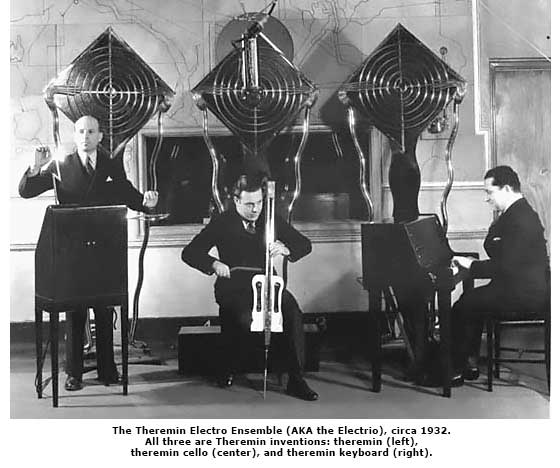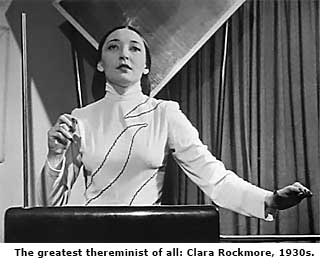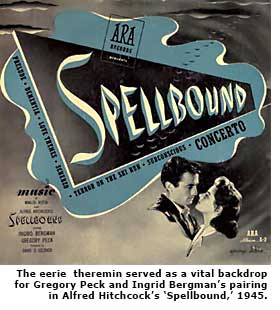From Russia with Modernism: Theremin - Page 2
Theremin's career had evolved alongside the Soviet state, but expanded way beyond geographic and ideological borders, and ultimately outlasted the USSR. He was born in 1896 in St. Petersburg, the grandson of the Tsar's court physician, and was already experimenting in the new field of electronics by the time the Russian Revolution had dethroned and executed Tsar Nicholas II, in 1918.
While devising an apparatus to measure the density and electrical properties of gases under varying conditions of pressure and temperature, Theremin found a way to make the gases 'whistle' through earphones. An unexpected and fateful side effect was that the whistle altered in pitch with every nearby movement of Theremin's hands.
An amateur cellist, the budding inventor perceived the potential application of technology to music and fabricated a primitive loudspeaker so that his creation could be heard by others. In 1920, he was ready to demonstrate his 'etherphone' to a bemused group of students, for whom he performed Saint-Saëns' 'Swan' and Massenet's 'Elegy.'
Two years later, he guided the hands of Soviet leader Vladimir Ilyich Lenin through a performance of Glinka's 'Skylark,' and thus won official government approval of his new instrument.
After Theremin's marriage and Lenin's demise, in 1924, the military intelligence unit of the Red Army supported the idea of a European tour for Theremin and his creation, now called a 'termenvox,' hoping that the inventor might engage in technological espionage while showcasing his achievement on behalf of the Soviet state.
Positive press prompted an invitation from the United States, and Theremin was welcomed to New York in 1927 by the Fords, Astors, and Guggenheims, alongside other jazz-age glitterati and the upper crust of the classical music community.

Tall and possessed of vulpine movie-star good looks, Theremin quickly gained an American following. He extended his stay, taking up residence in midtown Manhattan, formed a corporation, and in 1929 granted licensing and manufacturing rights under his patents to the up-and-coming Radio Corporation of America (RCA).
RCA renamed the instrument after its Russian inventor, and Theremin busied himself with performances and the creation of other theremin-like instruments, including fingerboard and keyboard models. In an ensemble dubbed 'The Electrio,' two of these models were combined with the original theremin and broadcast over the WJZ network in 1931. Theremin's later 'terpistone' invention elicited music from the body movements of one or more dancers.

Less publicly, Theremin designed surveillance devices for American consumption while sustaining his status as an information source for the Soviets, serving as something close to a double agent.
Among Theremin's musical customers was a teenaged Russian expatriate and ex-violinist named Clara Reisenberg. Later to be known as Clara Rockmore, she took to the theremin as if born to it, quickly manifesting an accuracy of intonation difficult to achieve on the instrument, whose electronic design made it more inclined to approximate pitch and glissando.
Ultimately, through her performances and a few recordings, Clara became the abiding gold standard for thereminists, far exceeding Theremin himself and most who came after her. As noted in Albert Glinsky's authoritative biography, 'Theremin: Ether Music and Espionage,' "Clara devised her own hand positions and gestures. She found that by keeping the tips of her right-hand thumb and forefinger in contact, she could achieve steadiness and control in the vibrato. She also developed 'aerial fingering,' a system where individual fingers would extend and withdraw from the right hand for subtle, refined control of melody within the electrical field—another technique adapted from violin."
Despite their age gap—or perhaps somewhat because of it—Theremin, estranged from his Russian wife Katia, came under the spell of the attractive and talented Clara, and began courting her. But in 1933 Clara married entertainment lawyer Robert Rockmore, taking his surname as her legal and stage name.
As Rockmore strived to validate the theremin's place in the classical repertoire, others began featuring the instrument as a novelty in popular bands, including the Hal Hope Orchestra, led by Samuel Hoffman, a chiropodist by day and a thereminist by night. As a precursor of its mid-century sci-fi function, the theremin was used as the buzzing sound on the popular 'Green Hornet' radio adventure broadcasts.





